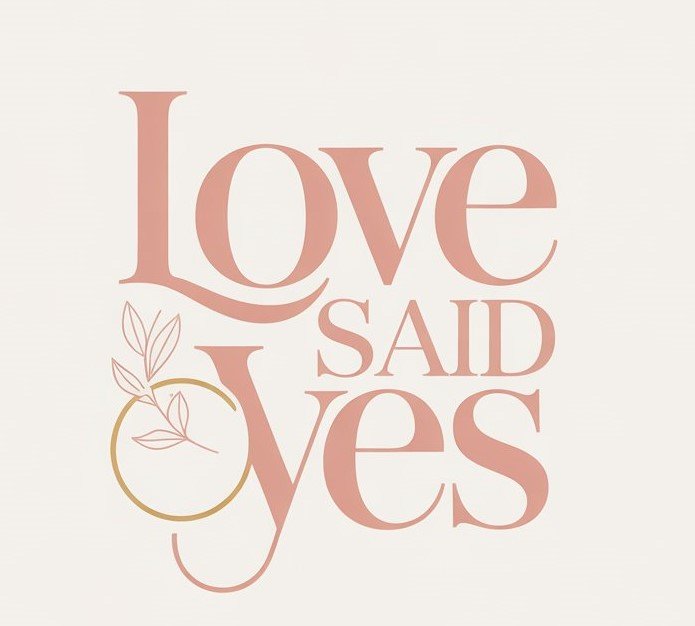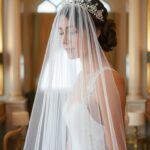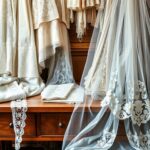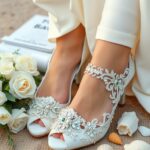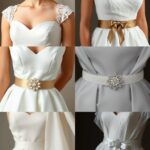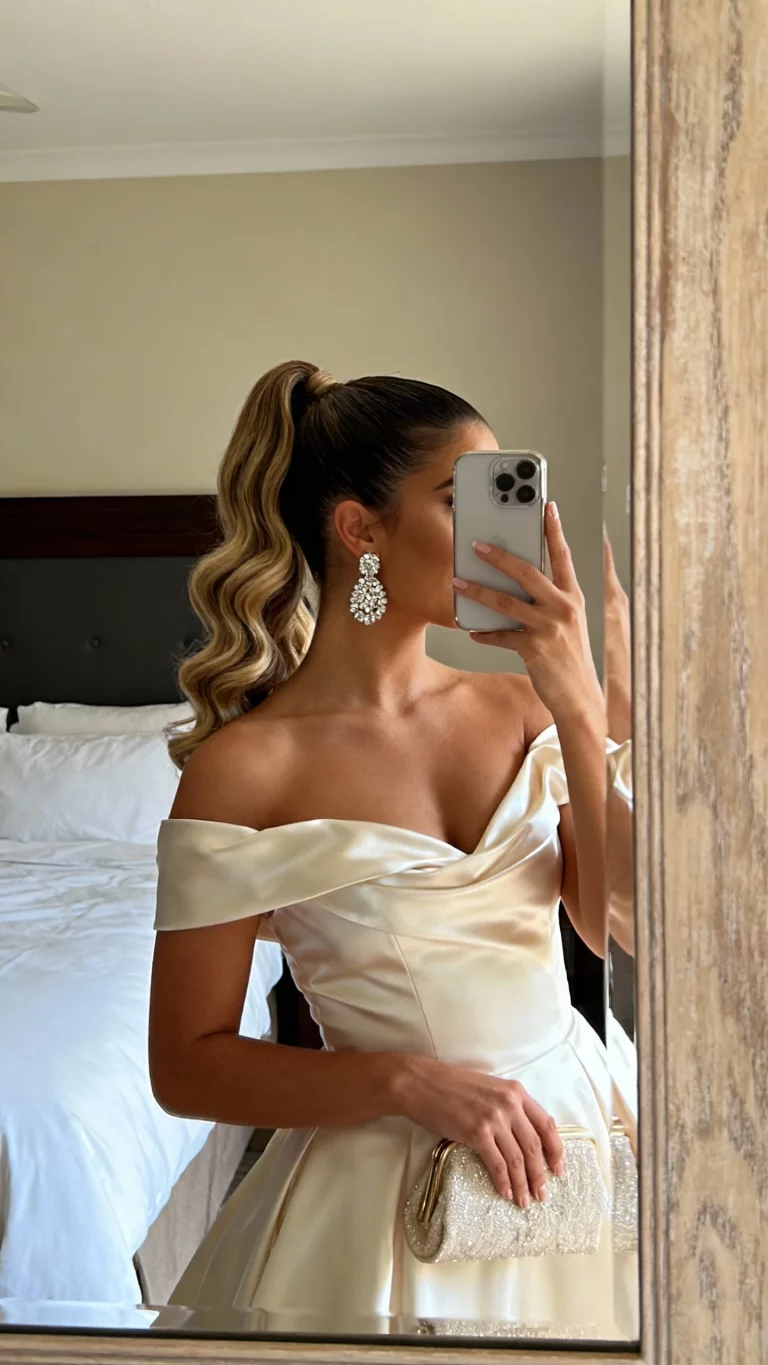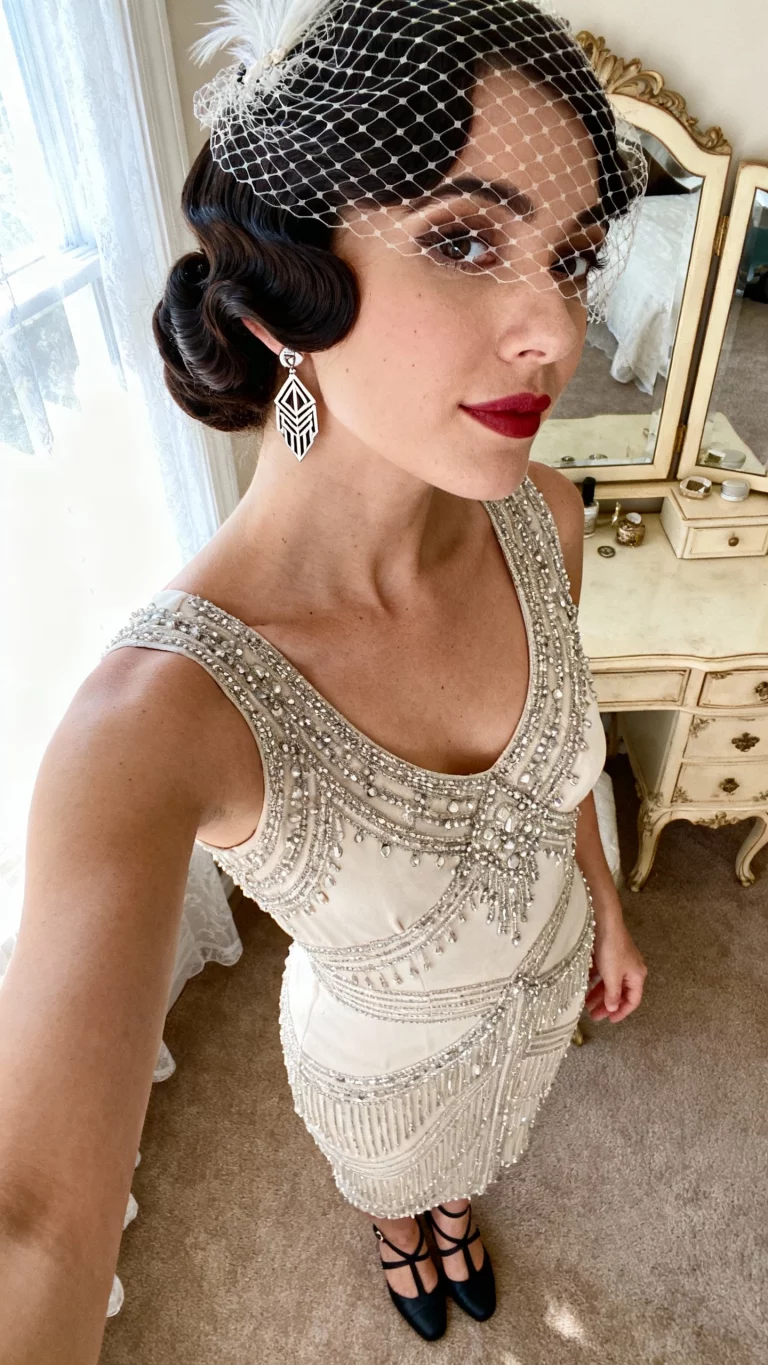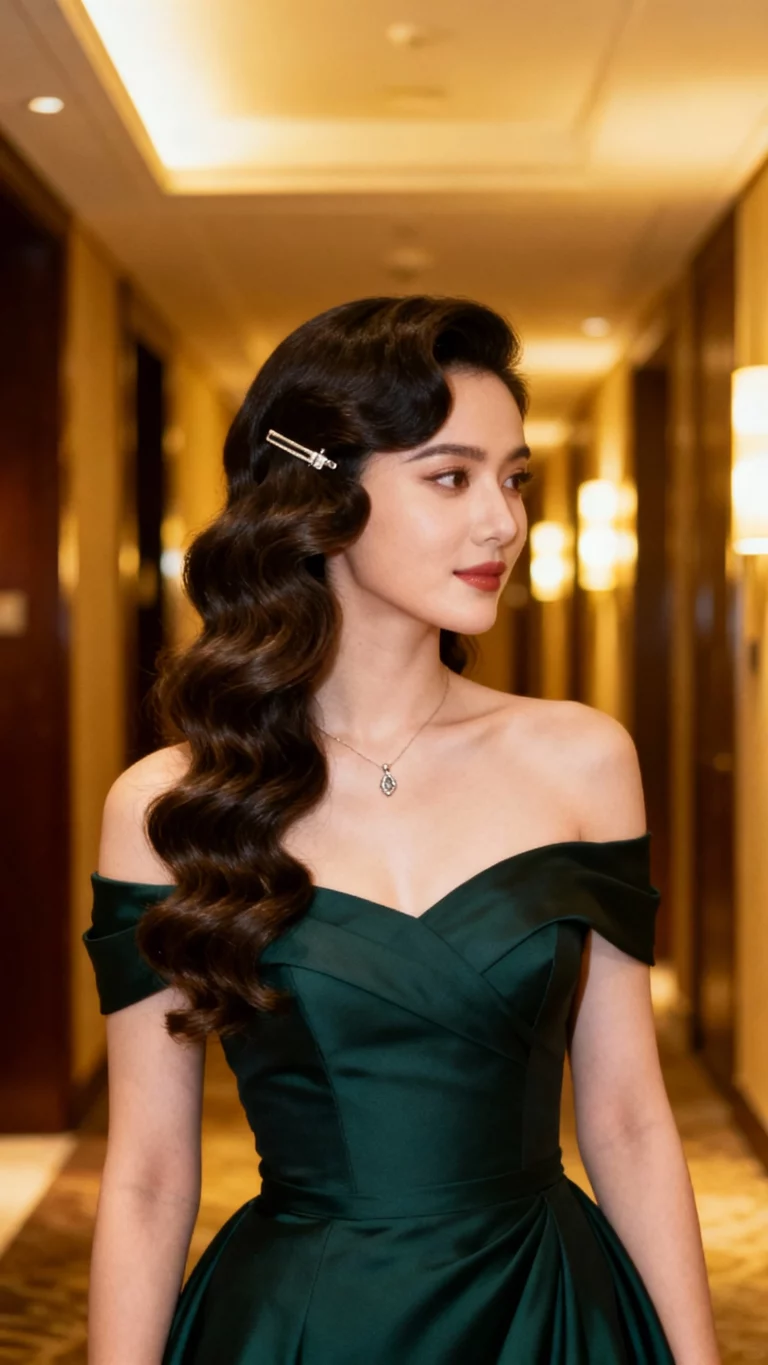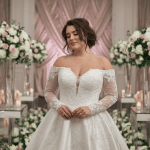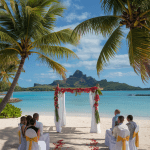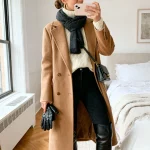Choosing the perfect bridal veil can elevate your wedding look and complement your dress beautifully. Start by considering your dress’s silhouette, neckline, and length. Different styles of veils—like birdcage, chapel, or cathedral—vary in length and can enhance certain designs. For instance, a fitted or mermaid dress pairs well with a simple veil, while a ball gown might call for something more dramatic. Don’t forget to think about how your veil works with your hairstyle and any accessories you plan to wear; it’s all about creating a coordinated and stunning ensemble for your big day!
Matching Your Veil to Your Hairstyle
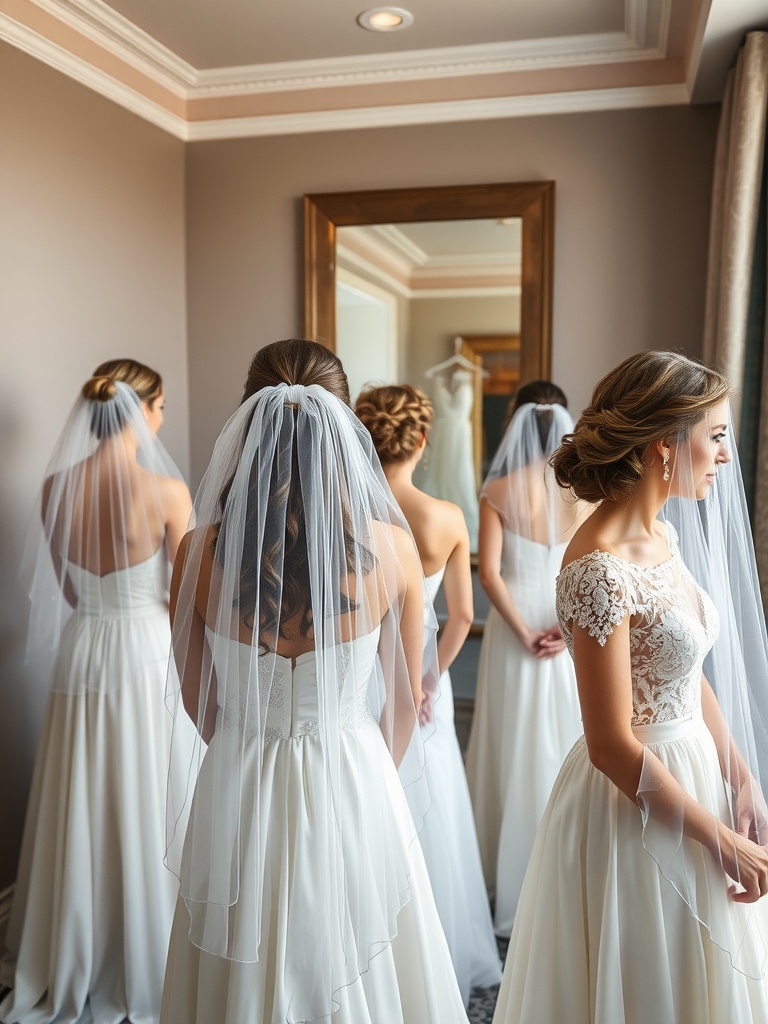
Choosing the right bridal veil is a fun part of planning your wedding look. It can enhance your entire outfit, especially when paired with the perfect hairstyle. First, think about your dress silhouette. A fitted gown looks stunning with a simple veil, while a ball gown can handle something more dramatic.
Next, consider the neckline of your dress. If you’re wearing a strapless or off-the-shoulder gown, a longer veil can add a touch of elegance. For high-neck or capped-sleeve dresses, shorter veils or birdcage styles might be the way to go.
Wedding veil lengths vary from shoulder-length to cathedral. For example, a chapel-length veil works beautifully with a long train, while a fingertip veil pairs nicely with mid-length dresses. Each style has its charm, so think about what feels right for you!
Lastly, don’t forget your hairstyle. If you’re keeping it simple with an updo, a longer veil can add drama. Loose waves can look beautiful with a shorter veil, letting your hair shine. Accessories, like clips or floral accents, can also complement your veil, tying your whole look together.
Embellishments That Complement
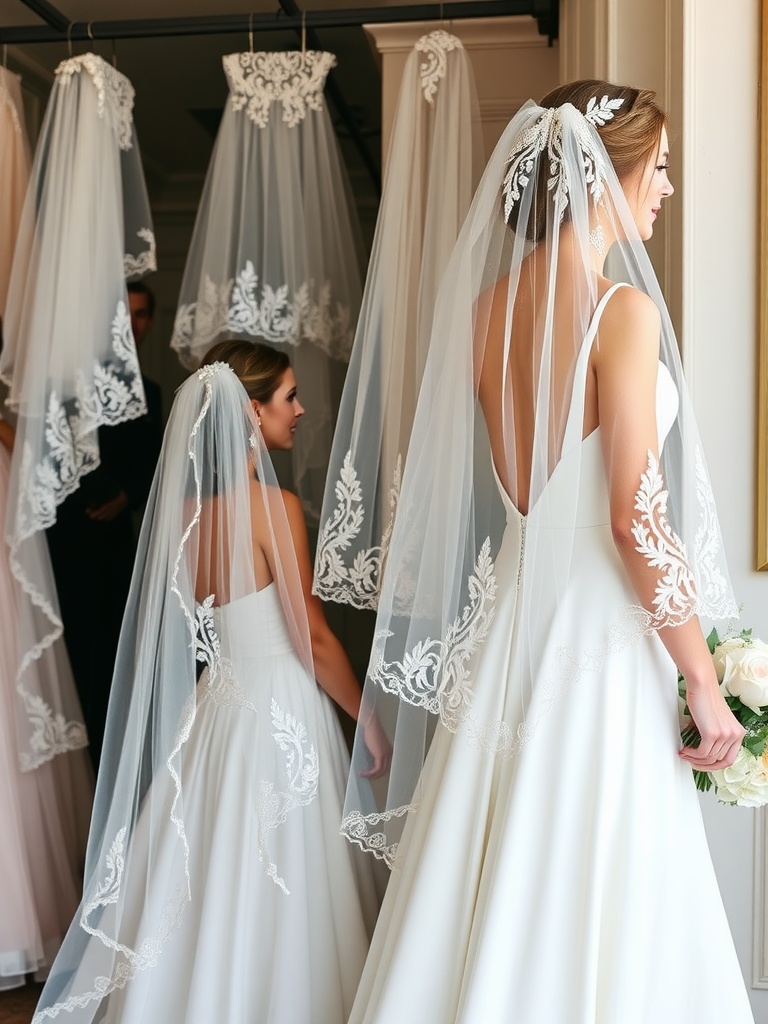
Choosing the right bridal veil is a fun way to enhance your wedding look. The image shows a variety of beautiful veils hanging alongside elegant dresses, each with unique embellishments. Let’s talk about how to match those embellishments to your dress.
Your wedding dress silhouette, neckline, and length all play a big role in choosing the perfect veil. For instance, if your dress has intricate beadwork or lace, a veil with similar details can create a cohesive look. On the other hand, if your dress is simple, a more elaborate veil can add dimension.
There are different veil styles for brides, such as cathedral, chapel, and fingertip lengths. A cathedral veil pairs nicely with a dramatic gown, while a fingertip veil suits a simpler silhouette. Don’t forget to consider how your veil will coordinate with your hairstyle and accessories. A veil with embellishments can complement a boho-chic hairstyle or an elegant updo.
When matching veil to dress, think about the overall vibe you want to create. Lacy edgings may match best with a vintage dress, while a sleek, plain veil can enhance a modern gown. So many options are available, and having a bridal veil guide can help you navigate your choices!
Understanding Wedding Dress Styles
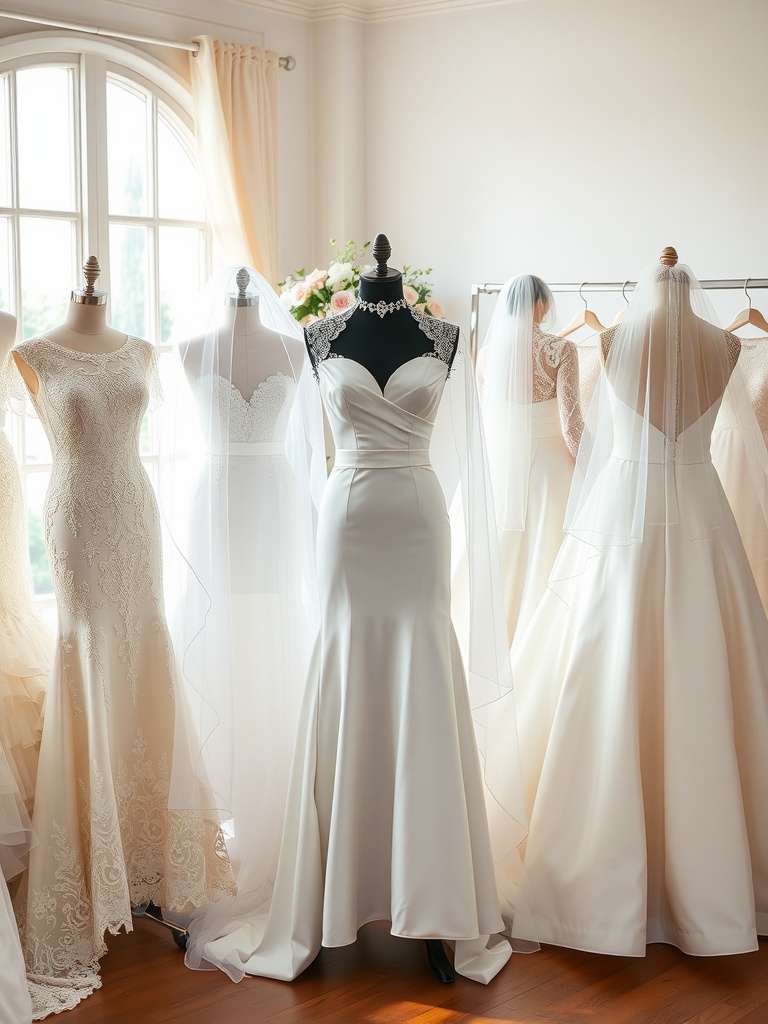
Choosing the right bridal veil is a key part of your wedding look. The image shows several stunning wedding dresses, each unique in style and design. It’s easy to get caught up in the dresses, but selecting the best veil for your wedding dress is just as important.
When figuring out how to choose a wedding veil, consider the silhouette of your dress. For example, a fitted gown pairs beautifully with a long, flowing veil. A ball gown might look fabulous with a shorter veil, creating a whimsical feel.
The neckline of your dress also plays a big role. Strapless dresses can showcase a dramatic veil, while high-necklines might benefit from simpler styles. A bridal veil guide can help match veil styles for brides with different necklines.
Don’t forget about length! Veil styles for brides typically range from birdcage veils to cathedral-length options. The right wedding veil lengths can enhance your overall look. If your dress has a train, a longer veil will complement it beautifully.
Finally, consider your hairstyle and accessories. If you choose an intricate updo, a simple veil might be the best choice to avoid overwhelming your look. Matching veil to dress is all about balance and coordination.
Determining Your Veil Shape
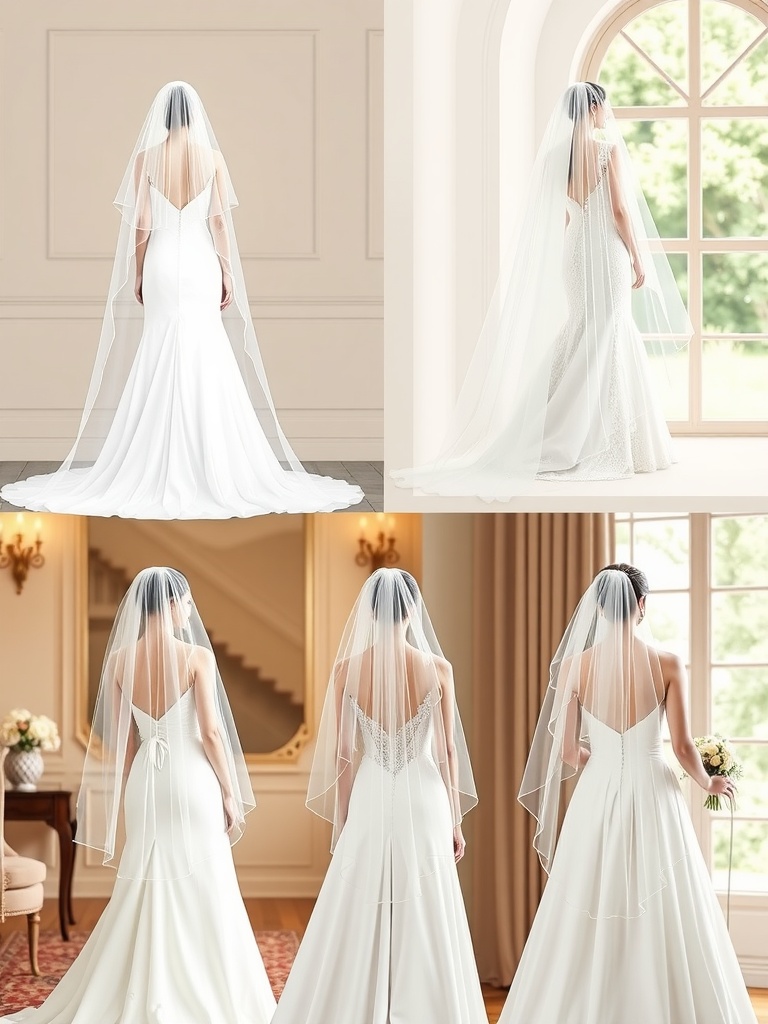
Choosing the right veil starts with understanding the shape that complements your wedding dress. The image showcases various bridal veils paired with elegant gowns, highlighting how different styles can enhance the overall look.
When selecting a veil, pay close attention to your dress silhouette. For fitted gowns, a simple, long veil can create a stunning silhouette. A fuller skirt, like an A-line or ball gown, pairs beautifully with a voluminous veil that adds a touch of drama. This way, you can find the best veil for wedding dress that suits your unique style.
Next, consider the neckline of your dress. A strapless gown looks fantastic with a cathedral veil, while a high-neck dress pairs well with a shorter, more delicate style. Veil styles for brides can vary widely, so take the time to explore different options to match your dress perfectly.
The length of the veil is another key factor. Typical lengths range from shoulder-length to cathedral. If your dress has intricate details, a shorter veil might be more appropriate to keep the focus on the gown. On the other hand, a longer veil can create a dramatic effect with a more ornate dress.
Finally, think about your hairstyle and accessories. A sleek updo can be beautifully accented with a cascading veil, while loose waves might work better with a more structured style. Coordinating these elements will help you achieve a cohesive bridal look that reflects your personality.
Choosing Veil Materials
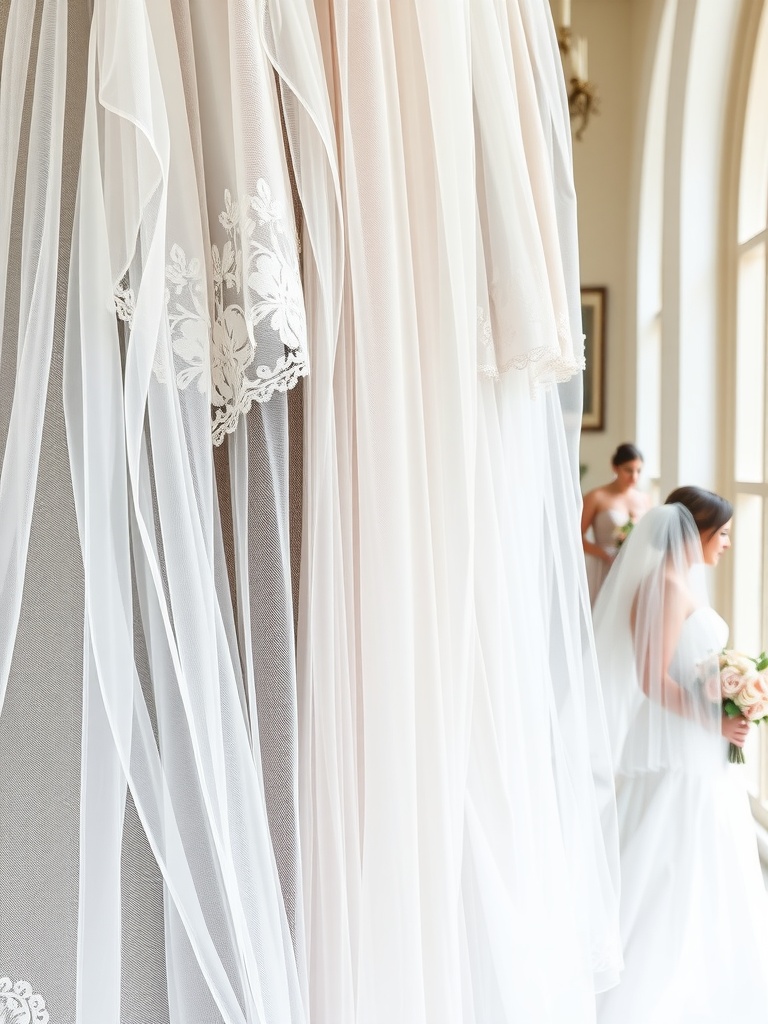
Choosing the right veil is a fun part of wedding planning! The right materials can elevate your bridal look, making it feel cohesive with your wedding dress. In this image, you see a collection of veils, each with its own charm.
Start by considering the silhouette of your dress. If you have a fitted dress, a simple, lightweight veil may be perfect. For a ball gown, a longer veil can add a dramatic flair. The neckline also plays a key role. A strapless gown pairs beautifully with a veil that has some volume, while a high-neck dress might be complemented by a more delicate style.
When it comes to veil styles, options include cathedral, chapel, and fingertip lengths. Cathedral veils are the longest, typically trailing behind you, while fingertip veils just touch the tips of your fingers. Each length serves to enhance your overall look differently.
Materials matter, too! Tulle is a popular choice for its softness and volume, while lace adds a romantic touch. If your dress has intricate beading, a sheer veil might allow those details to shine through. When thinking about how to choose a wedding veil, remember to factor in your hairstyle. A delicate veil can work well with an updo, while loose waves might suit a fuller veil.
In summary, whether you’re matching your veil to dress or looking for the best veil for your wedding dress, keep your ensemble in mind. This bridal veil guide will help you find the perfect match!
Color Matching Your Veil
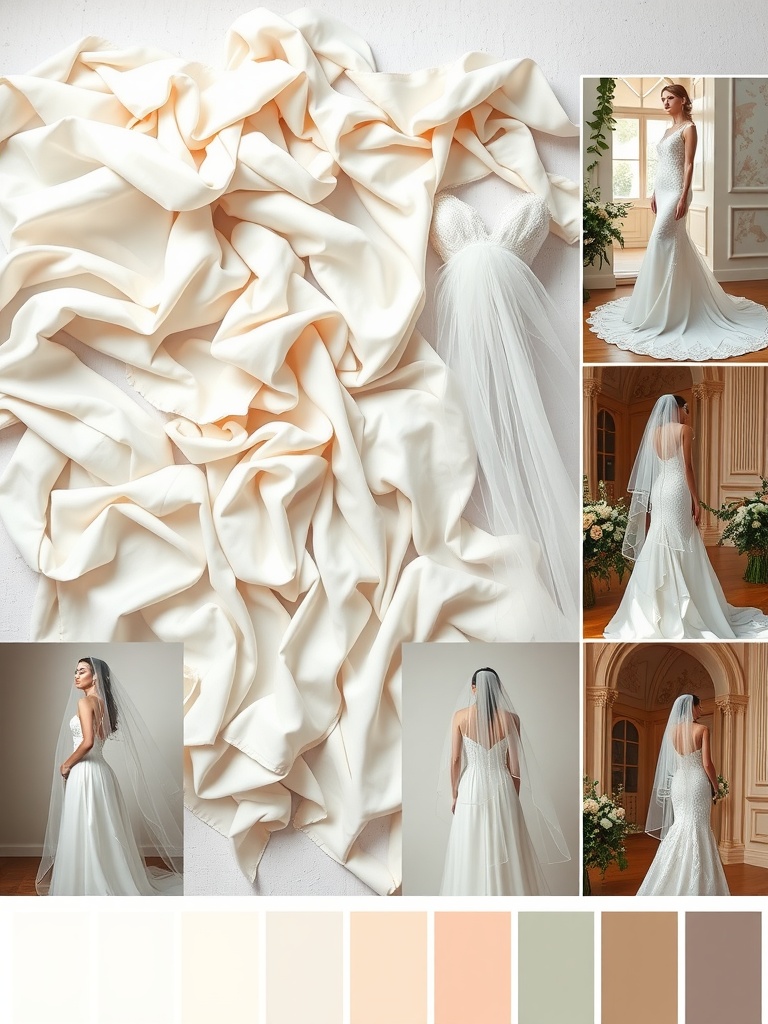
Choosing the right bridal veil is key to completing your wedding look. The color of your veil should complement your dress, ensuring a harmonious appearance. In the image, you can see an array of soft colors paired with a beautiful gown, showcasing how different veil shades can work with various fabrics.
When matching your veil to your dress, start by considering the fabric and color of your gown. If your dress is a classic white, opt for a veil in a similar shade, like ivory or champagne, to maintain a cohesive look. This can enhance the elegance of your ensemble without clashing or distracting from the overall design.
Next, think about the dress silhouette and neckline. A fitted gown might pair beautifully with a simple, long veil, while a more elaborate dress can benefit from a more decorative style. Veil styles for brides vary greatly, so explore options like cathedral, fingertip, or shoulder-length veils to see what complements your dress best.
Don’t forget about veil lengths! Cathedral veils are dramatic and perfect for a grand wedding, while shorter styles are chic and modern. The length of your veil can also tie into your hairstyle. For instance, if you’re wearing an updo, a longer veil can add drama, while a shorter one might look lovely cascading over loose waves.
As you finalize your choice, keep the wedding theme in mind. A vintage-inspired dress may call for lace trims on the veil, while a sleek, modern gown might be enhanced with a minimalist design. This bridal veil guide is all about finding the right balance, so take your time and enjoy the process!
Veil Length and Its Impact
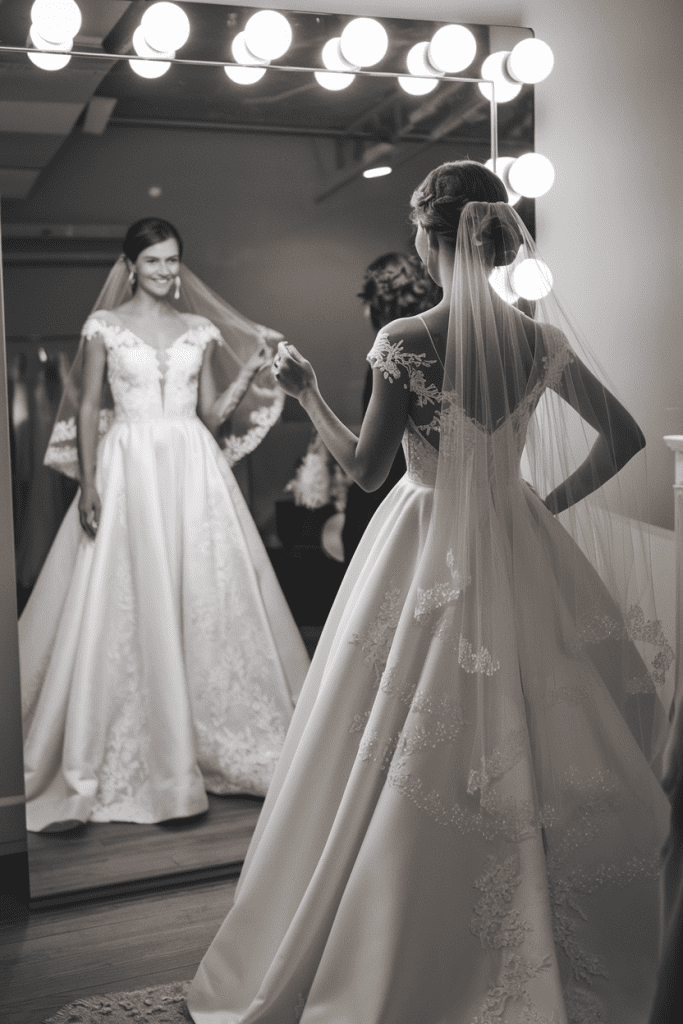
Choosing the right veil length can make a big difference in how your bridal look comes together. The image shows a beautiful bride wearing two different styles of veils, highlighting their unique lengths and effects. Each veil type can complement various dress styles and silhouettes.
When selecting the best veil for your wedding dress, think about the silhouette of your gown. For example, if you have a flowy A-line dress, a longer veil can create a dreamy, romantic look. On the other hand, if your dress is fitted or has intricate detailing, a shorter veil may be ideal to keep the focus on the dress itself.
Next, consider the neckline of your dress. A classic veil length, like the chapel or cathedral veil, works beautifully with strapless or off-the-shoulder designs. In contrast, a birdcage veil could add a fun touch to a more modern or vintage-inspired gown.
Typical veil lengths include fingertip, chapel, and cathedral. Fingertip veils tend to hit right around your fingers, which is great for a touch of elegance without overwhelming your look. Chapel veils trail just behind the dress, ideal for a formal setting, while cathedral veils are longer and dramatic, making them perfect for grand occasions.
When thinking about veil styles for brides, remember to coordinate with your hairstyle and accessories. A long veil might look stunning with an updo, while a shorter veil can pair nicely with flowing locks. Accessories like hairpins or floral accents can enhance your overall look, so choose them wisely.
Seasonal Considerations for Veils
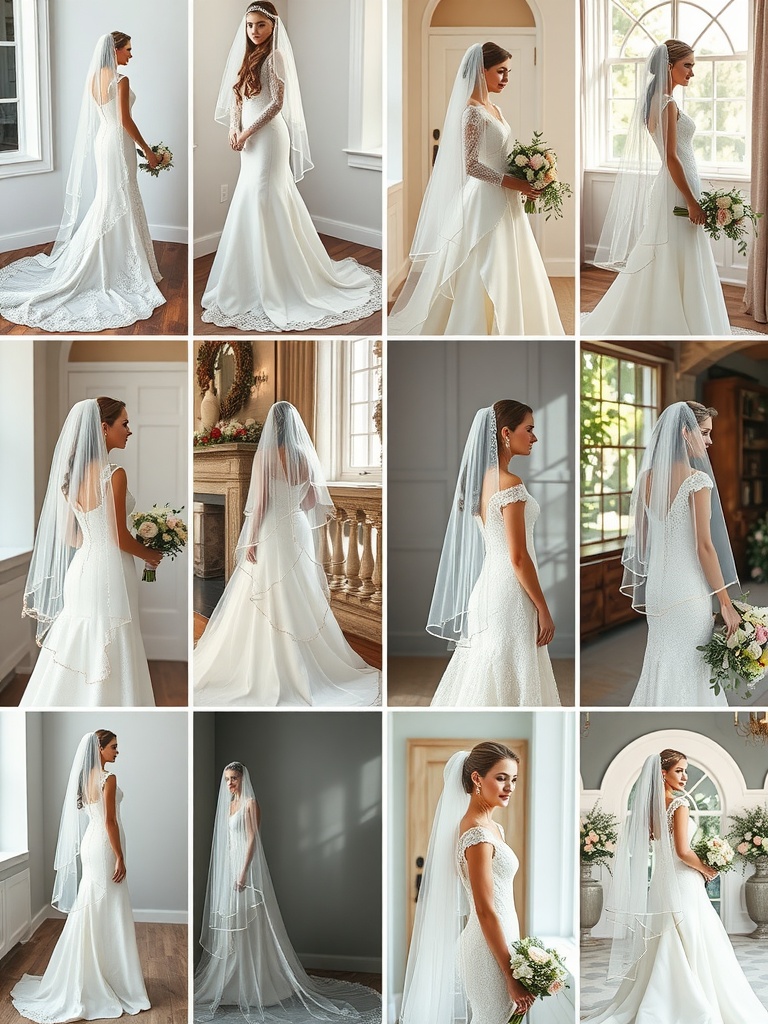
When thinking about how to choose the perfect bridal veil, the season of your wedding plays a significant role. Different seasons bring unique vibes and challenges that can influence your choice. For a spring wedding, lightweight veils like tulle or lace can add a soft, romantic touch, complementing the blooming flowers around you.
In summer, consider breathable fabrics that won’t weigh you down. A sheer veil can keep you cool while still providing that dreamy look. If you’re tying the knot in the fall, richer fabrics like satin or velvet can add warmth and a touch of luxury to your outfit, matching the seasonal colors beautifully.
Winter weddings call for something special. A longer veil can be dramatic and elegant, especially when paired with a stunning gown. Look for veils adorned with crystals or heavier lace, which can also keep you cozy. The key here is to balance warmth with style while matching the veil to your dress.
When you’re choosing a veil, pay attention to the silhouette and neckline of your dress. For example, if your dress has a high neckline, a shorter veil might be the best fit, while a plunging back can beautifully showcase a long cascading veil. Remember, matching veil to dress is crucial in creating a harmonious look.
Veil lengths vary widely, from birdcage veils that barely cover the face to cathedral veils that trail behind you. Think about which style complements your dress. For instance, a chapel veil can work beautifully with most silhouettes, adding a touch of drama without overpowering the dress.
Finally, coordination with hairstyles and accessories is vital. A simple veil may pair well with an intricate updo, while a more embellished veil could balance a simpler hairstyle. Keep these tips in mind, and you’ll find the best veil for your wedding dress!
Budgeting for Your Bridal Veil
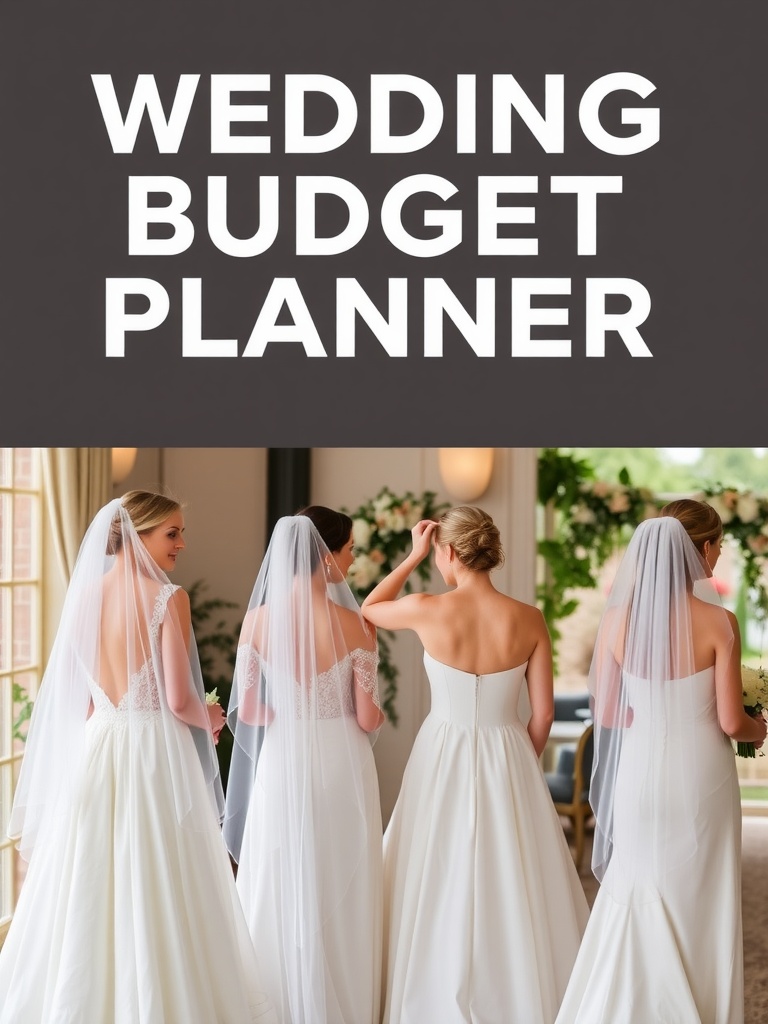
Choosing the right bridal veil can feel overwhelming, especially with so many styles and lengths available. The image shows brides showcasing different veils, which highlights the variety you can explore. When budgeting for your veil, it’s essential to keep your dress style in mind.
The best veil for your wedding dress should complement its silhouette and neckline. For example, if you have a fitted gown, a cathedral-length veil can add drama. On the other hand, a sheath dress might pair well with a shorter veil. Understanding veil styles for brides is crucial for making the best choice.
Typical veil lengths include birdcage, elbow, fingertip, and cathedral. Your choice will impact not just your budget but also how the veil fits with your overall look. Think about how the chosen length will flow with your hairstyle and accessories. A simple hairstyle might work well with a more elaborate veil, while intricate hairstyles can benefit from a more understated option.
Don’t forget to check for any embellishments on your dress. A veil with similar detailing can be a nice touch, bringing your look together nicely. When budgeting, be open to various options, and remember that a veil can be a beautiful investment in your wedding day look.
Care and Preservation of Your Veil
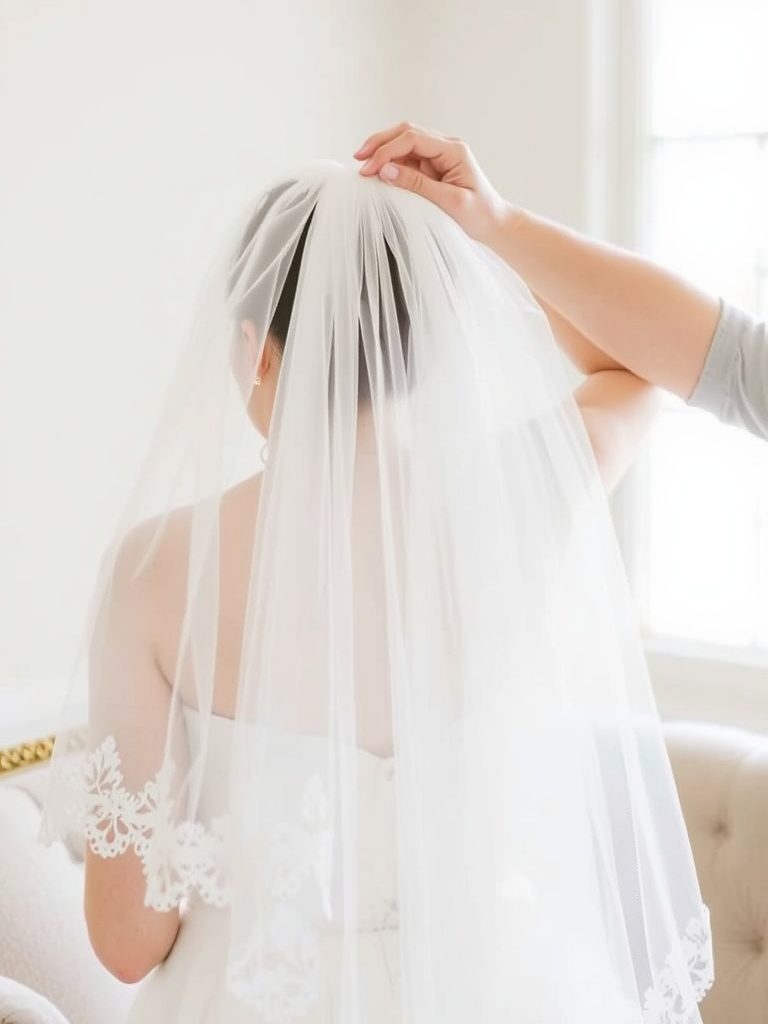
Choosing the right bridal veil can truly enhance your wedding dress. In the image, you see a stunning gown paired with various veil styles, showcasing how different lengths and designs can complement different silhouettes. From long cathedral veils to shorter fingertip options, the choice can affect the overall appearance of your look.
When it comes to care and preservation, handling your veil properly is essential. Start by storing it in a cool, dry place, ideally in a breathable garment bag to prevent dust and damage. Avoid plastic bags, as they can trap moisture and lead to mold.
For preservation, consider having your veil professionally cleaned after the wedding. Check the fabric type; lace and tulle may require different cleaning techniques. Always follow care instructions to keep your veil looking its best.
When matching your veil to your dress, consider the neckline and dress silhouette. A simple A-line gown pairs beautifully with a long, flowing veil, while a sleek mermaid style might look best with a shorter veil. Play around with veil styles for brides to find what resonates with your vision.
Lastly, think about your hairstyle. If you plan to wear an updo, a longer veil can add drama, while a shorter veil can suit loose curls or waves. The right combination of these elements can create a cohesive and beautiful bridal look.
Personalizing Your Veil
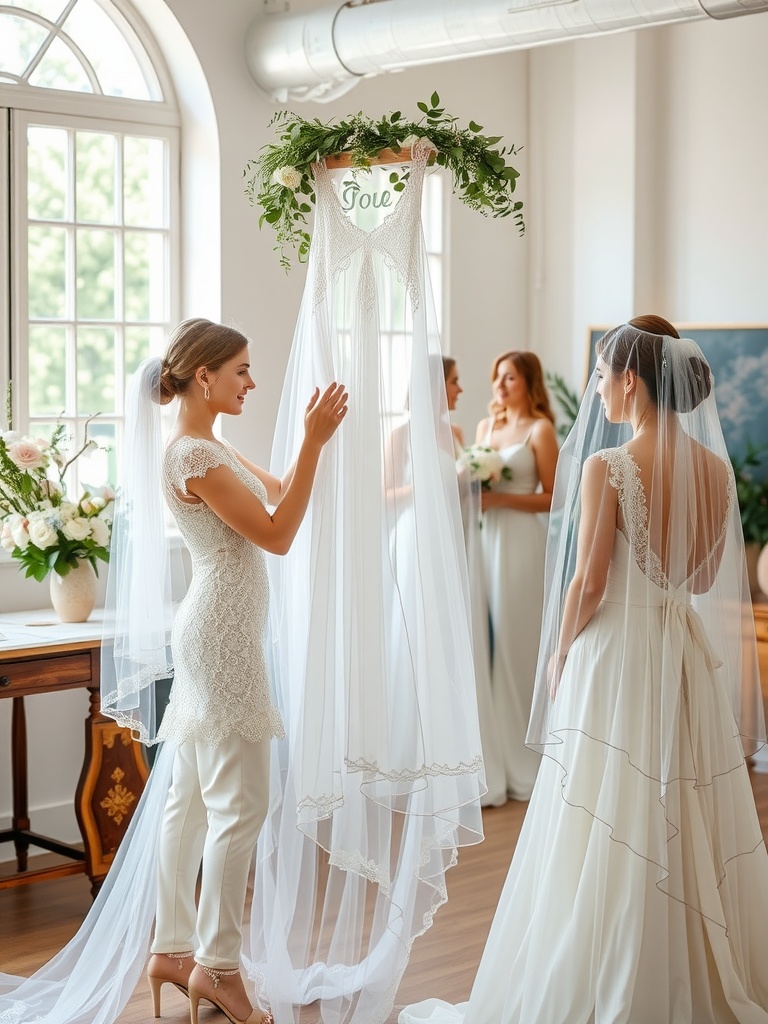
Choosing the right bridal veil can make your wedding look truly unique. In the image, you see bridesmaids and brides exploring different veil styles, which is an exciting part of the planning process. Personalizing your veil is all about matching it perfectly with your dress.
Start by considering the silhouette of your wedding dress. A fitted gown pairs well with a long, flowing veil, while a ball gown may look stunning with a shorter style. Understanding wedding veil lengths can help you decide which type will complement your dress best.
The neckline of your dress also plays a big role. For a strapless or sweetheart neckline, a cathedral veil can add drama, while a simple elbow-length veil might work better with a higher neckline. This bridal veil guide will help you navigate through these choices.
Different veil styles for brides include lace-edged, birdcage, and floral appliqué. Each style brings a different vibe to your overall look. If you want to keep it classic, go for a traditional tulle veil. For something modern, consider a sleek satin finish.
Don’t forget to coordinate your veil with your hairstyle and accessories. A delicate veil can enhance a simple updo, while a more elaborate one can stand on its own with loose curls. Matching veil to dress is all about balance!
In summary, take your time to explore the options that fit your personal style and dress design. The right veil will not only complete your look but also tell your unique love story.
Veil Versatility for Different Ceremonies
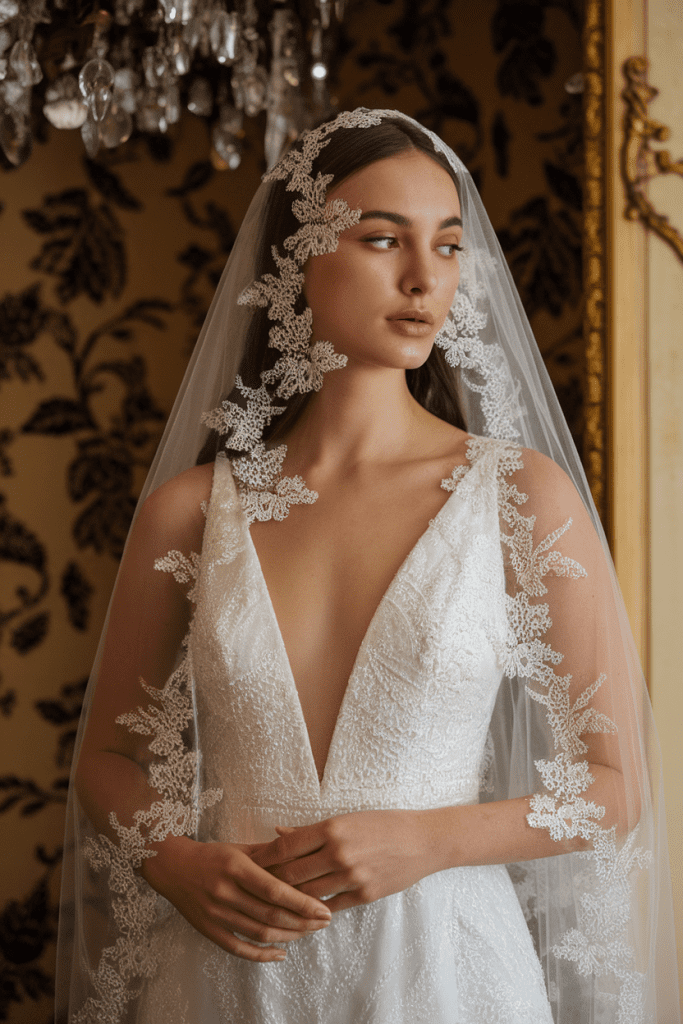
Choosing the right veil can elevate your wedding look, especially when you consider the type of ceremony. The image shows various veil styles that can complement different wedding dresses. Each style comes with unique lengths and designs, making it easier to match the veil to your dress.
When thinking about veil styles for brides, consider the silhouette of your dress. For example, a flowing A-line dress pairs beautifully with a longer veil, while a fitted mermaid gown might look stunning with a shorter option. The length of your veil, such as elbow-length or cathedral, can dramatically change your overall look.
Necklines also play a big role in your veil choice. A strapless dress often suits a simple, longer veil that cascades down the back, while a dress with intricate detailing around the neckline might call for a more delicate, shorter style. This way, you won’t overshadow the beautiful work on your dress.
Don’t forget about coordinating with your hairstyle and accessories! If you’re going for an updo, a longer veil can add a lovely flow. For loose, wavy hair, a shorter veil or a birdcage style can really shine. Think about how the veil will frame your face and enhance your overall look.
In this bridal veil guide, remember to have fun with your choices. There are no hard rules here, just what makes you feel beautiful on your special day. So, take your time, mix and match styles, and enjoy finding the best veil for your wedding dress!
Trends in Bridal Veils
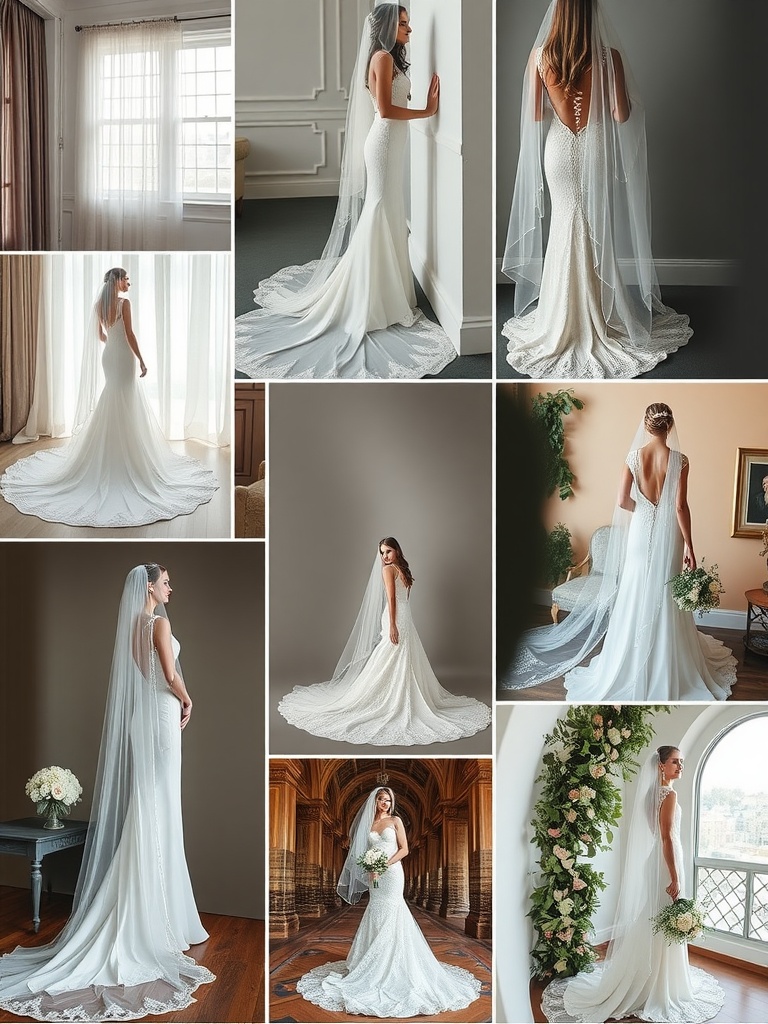
Choosing the right veil can make a big difference in how your bridal look comes together. The image showcases various styles of brides wearing different veil lengths and designs that align beautifully with their wedding dresses. Each gown complements the veil, highlighting the importance of matching veil styles for brides with their dress silhouettes and necklines.
When it comes to wedding veil lengths, options like birdcage, elbow-length, and cathedral veils cater to different styles. For a fitted gown, a long veil can create a stunning visual impact, while a shorter veil might work better with a tea-length or A-line dress. Understanding how to choose a wedding veil based on these aspects is key to looking your best on the big day.
Different veil styles, such as lace-trimmed or plain tulle, add unique touches to the overall look. It’s helpful to consider the details of your dress. For example, if your dress has intricate beading, a simple veil may allow your gown to take center stage. Matching veil to dress becomes easier when you think about texture and embellishments.
Also, consider how your hairstyle will work with the veil. For updos, longer veils can create a dramatic effect, while down styles might pair better with shorter veils. Being mindful of these elements will help you find the best veil for your wedding dress, ensuring you feel confident and beautiful.
Consulting with Bridal Stylists
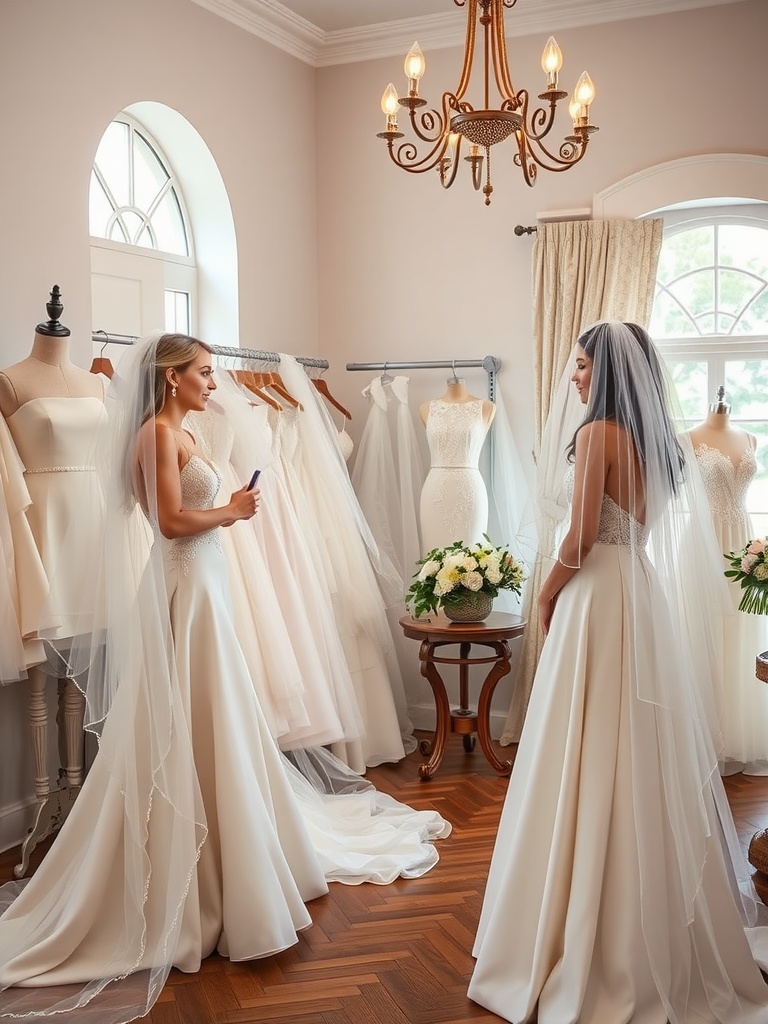
Choosing the right bridal veil can feel overwhelming, but consulting with a bridal stylist makes the process much easier. These experts can help you understand how to choose a wedding veil that fits perfectly with your dress.
Start by considering your dress’s silhouette. A fitted gown pairs well with a classic cathedral veil, while a ball gown looks stunning with a longer veil that cascades elegantly. A-line dresses often suit mid-length veils, creating a balanced look. Remember, the veil style should enhance your dress, not compete with it.
Next, think about the neckline of your dress. A strapless gown can be beautifully complemented by a long, flowing veil, while a high-neck dress might shine with a shorter style. Veil lengths vary, typically categorized as birdcage, shoulder, elbow, fingertip, and cathedral. Each has its charm, so pick one that matches your dress’s design.
Don’t forget about your hairstyle and accessories! If you’re wearing your hair down, a layered veil can add texture. For updos, a shorter veil might create a chic contrast. Matching your veil with hairpieces or jewelry will pull your entire look together.
Understanding Veil Attachment Options
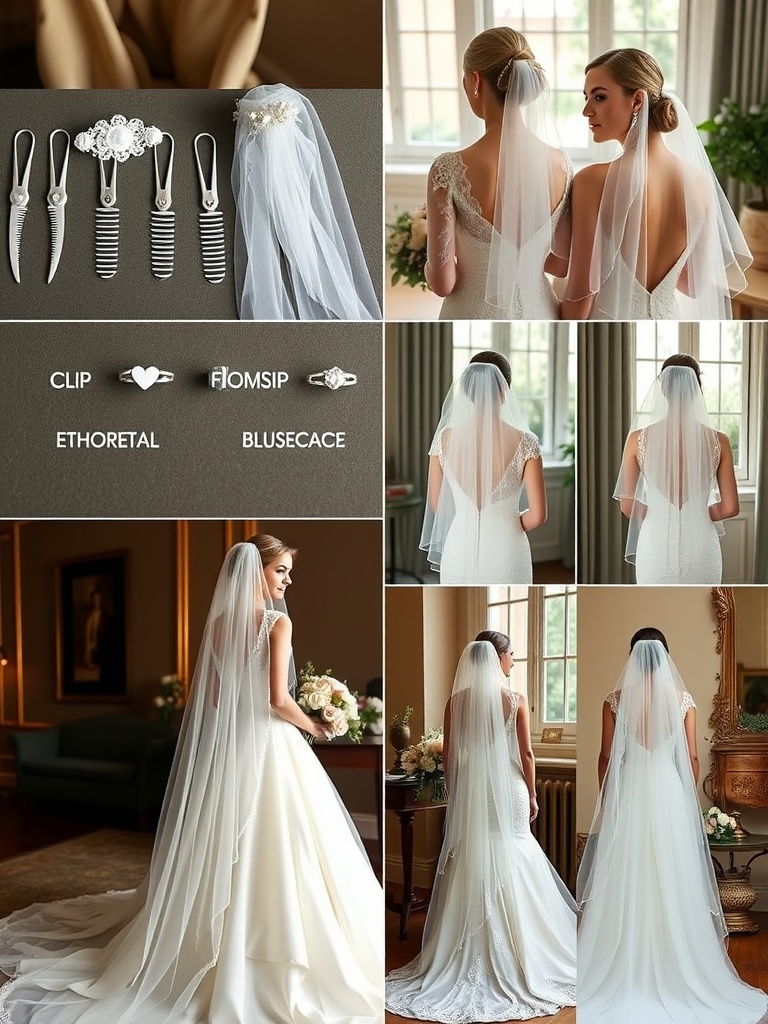
Choosing the right veil can be just as important as selecting your wedding dress. The way your veil attaches impacts both its look and how it complements your silhouette. In the image, you can see various attachment options, from clips to combs, each offering a unique style. Understanding these options can help you match your veil to your dress perfectly.
Different veil lengths can also affect your overall appearance. For instance, a birdcage veil is usually short and pairs well with vintage-inspired dresses, while a cathedral veil adds drama and is ideal for formal gowns. Make sure to consider the length of your dress when choosing your veil length to create a cohesive look.
The dress silhouette is another key factor. A ball gown might look stunning with a fuller veil, while a fitted sheath dress may be best complemented by a simpler style. Pay attention to the neckline as well; veils that are attached at the back work nicely with dresses that have an open back, allowing for a seamless flow.
When matching the veil to your dress, think about how your hairstyle will interact with it. If you have an updo, a longer veil will create a beautiful cascading effect. For hairstyles that are down, a shorter veil might be more suitable. Accessories like hairpins or floral accents can also be coordinated with the veil for a unified look.
